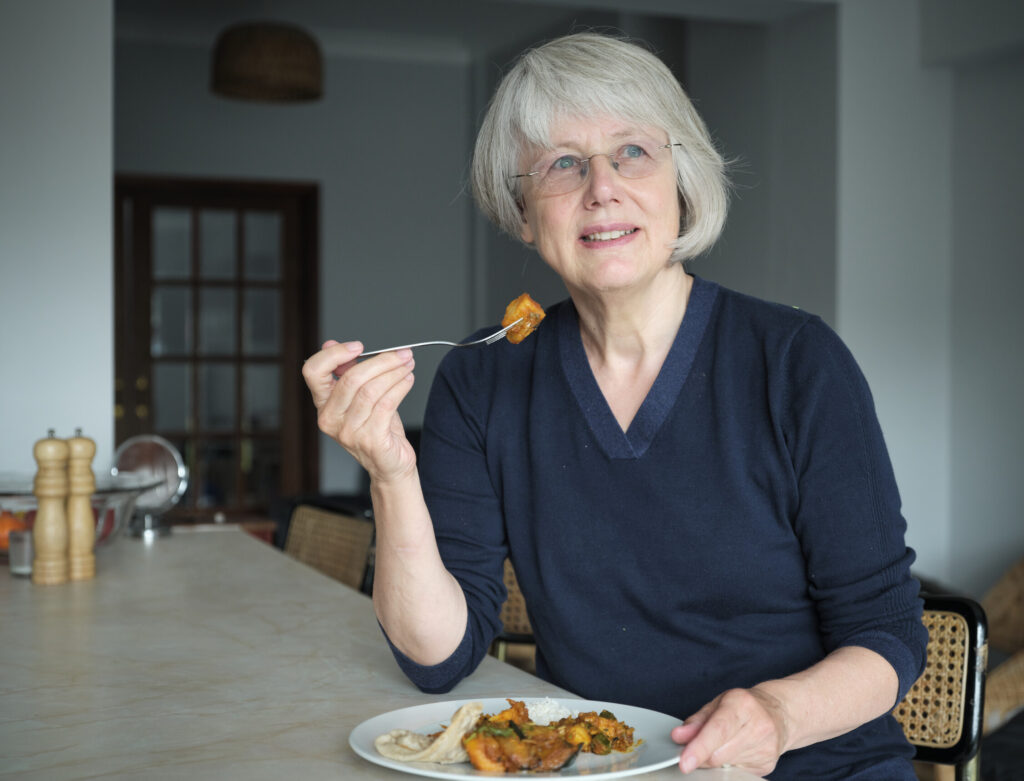A holistic approach to eating
The The Australian government’s Eat for Health website has some helpful and easy to follow recommendations on how we can nourish our bodies as we age. These guidelines focus on eating nutritious foods that satisfy our energy needs and promote overall wellbeing and encourage us to embrace a diverse range of foods from the five recommended food groups. It is important to remember that we are not aiming for perfection (which is not a realistic goal). It isn’t necessary to consume from every food group daily; instead, try finding foods that work best for us individually.
Think about using the guidelines as a way to embrace a holistic approach to eating that supports our wellbeing and celebrates the diverse pleasures of food – not as a rigid set of rules.
We have outlined here some of the recommendations made by the Australian Dietary Guidelines.
Consume nutritious food and drink that meet our energy needs and keep us feeling satisfied. This can help to maintain muscle strength and better manage health problems. The best way to do this is by eating a variety of foods from the five recommended food groups and to follow the recommended number of serves.
Enjoy a variety of foods from the five food groups every day. This includes:
- A variety of types and colours of vegetables, legumes and beans
- Fruit
- Grains, preferably wholegrain or grains high in fibre, such as breads, rice, pasta and noodles
- Lean meats, poultry, fish, eggs, tofu and nuts
- Milk, yoghurt, cheese or alternatives such as plant milks with added calcium, and nuts high in calcium such as walnuts and almonds.

Drink plenty of water every day. Some studies have found that because our appetite and thirst tends to reduce as we age, we may not realise our bodies are craving water. It’s also common for us to be taking medication regularly that dehydrates us.
For these reasons it’s important to know how to recognise the signs of dehydration – some of them are:
- Dark-coloured urine or urinating less frequently
- Fatigue or feeling weak
- Irritability
- Dizziness or headaches
- Muscle cramps in arms or legs
- Dry mouth
- Confusion or lower cognitive function
Try to limit the amount of food high in saturated fat, salt or sugar, and alcohol. The Australian Dietary Guidelines recommend replacing these foods with other alternatives to help increase the nutritional value of the foods we eat.
While it is important to keep this in mind, limiting our relationship to food to being just about energy intake misses the nuance of what leads to unhealthy relationships with food. Making drastic changes to what we eat can also be challenging and hard to maintain for long. If you are wanting to make some changes to what you eat, start small and pick one or two achievable goals first. Talk to your doctor about your personal health needs.
More resources on nutrition for older women

- Eat for Health Calculators can help you work out your daily energy needs and nutrient requirements
- The Risk Checker can help you assess your risk for heart disease, type 2 diabetes, and kidney disease and give you tips on how to lower your risk
- Nutrition Australia outlines special considerations for older adults
- Better Health Nutrition needs when you’re over 65
- If you’re interested in reading more about the link between diet and arthritis, Arthritis Australia have lots of resources.
Arthritis Australia (2017) Healthy eating
Australian Human Rights Commission (n.d.) Chapter 4: The role and influence of the media
Bärebring L, Palmqvist, M, Winkvist, A et al. (2020) Gender differences in perceived food healthiness and food avoidance in a Swedish population-based survey: a cross sectional study. Nutrition Journal
Bernstein M (2017) Nutritional needs of the older adult. Physical Medicine and Rehabilitation Clinics of North America. 28(4), 747-766
Better Health (2017) Nutrition needs when you’re over 65
Butterfly (2023) Body pride resources
Butterfly (2023) Boosting body image
Butterfly (2023) Health not weight
Butterfly (2023) LGBTQIA+ people, eating disorders and body image
Butterfly (2023) People from multicultural communities
Cameron E, Ward P, Mandville-Anstey SA, Coombs A (2018) The female ageing body: A systematic review of female perspectives on aging, health, and body image. Journal of Women and Ageing. 31(1): 3-17
Carrard I, Rothen S, Rodgers RF. (2020) Body image and disordered eating in older women: A tripartite sociocultural model. Eating Behaviours. 38(101412)
Carrard I, Rothen S. (2020) Factors associated with disordered eating behaviours and attitudes in older women. Eating and Weight Disorders – Studies on Anorexia, Bulimia and Obesity. 25: 567-575
Eat for Health (nd) Healthy eating when you're older
Eating Disorders Families Australia (2022) What is HAES?
Eating Disorders Victoria (2022) Eating disorders explained
Feel Good Eating (2021) What is HAES?
Hanna KL, Collins PF (2015) Relationship between living alone and food and nutrient intake. Nutrition Review 73(9), 594–611
Health Direct (2023) Risk checker
Hofmeier S, Runfola C, Sala M, Gagne D, Brownley K, Bulik C. (2017) Body image, ageing and identity in women over 50: The gender and body image (GABI) study. Journal of Women and Ageing. 29(1): 3-14
Kilpela LS, Becker CB, Wesley N, Stewart T. (2015). Body image in adult women: Moving beyond the younger years. Advances in Eating Disorders. 3(2): 144-164
My Aged Care (2023) Meals and food preparation
National Council on Ageing (2021) How to stay hydrated for better health
Nutrition Australia. (2021) Nutrition and older adults
Placzek O (2021) Socio-economic and demographic aspects of food security and nutrition. OECD Food, Agriculture and Fisheries Papers
Pontzer H, Yamada Y, Sagayama H, Ainslie P, Andersen LF, Anderson LJ, et al. (2021) Daily energy expenditure through the human life course. Science 373(6556): 808-812
ReachOut (2023) Support services for eating disorders
Samuels KL, Maine MM, Tantillo M (2019) Disordered eating, eating disorders, and body image in midlife and older women. Current Psychiatry Reports. 21(70)
Silva TR, Oppermann K, Reis FM, Spritzer PM (2021) Nutrition in menopausal women: A narrative review. Nutrients. 13(7)
Transhub (2021) Body image
Wallace TC, Bailey RL, Blumberg JB, Burton-Freeman B, Chen O, Crowe-White KM, et al. (2019) Fruits, vegetables, and health: A comprehensive narrative, umbrella review of the science and recommendations for enhanced public policy to improve intake. Critical Reviews in Food Science and Nutrition. 60(13)
Yeung SSY, Kwan M, Woo J (2021) Healthy diet for healthy ageing. Nutrients 13(12)